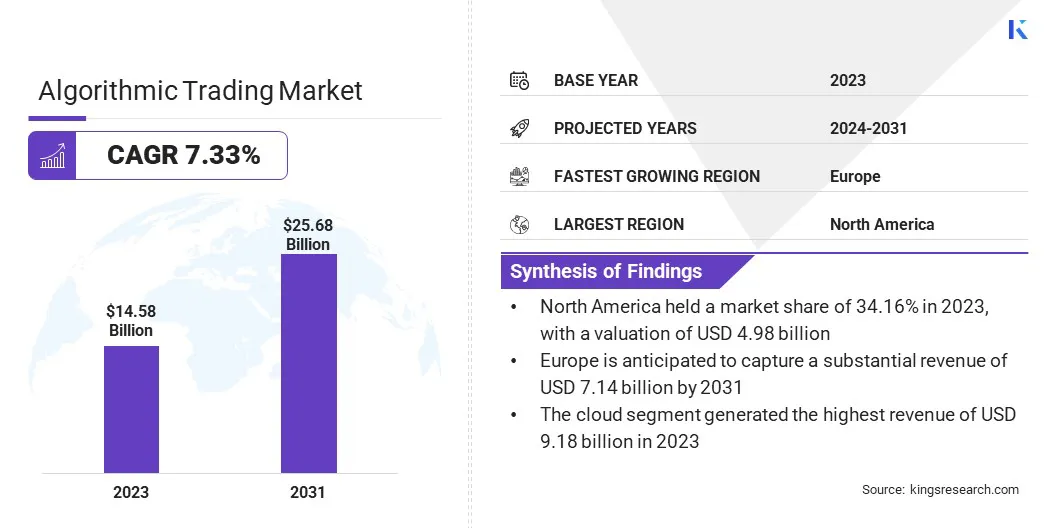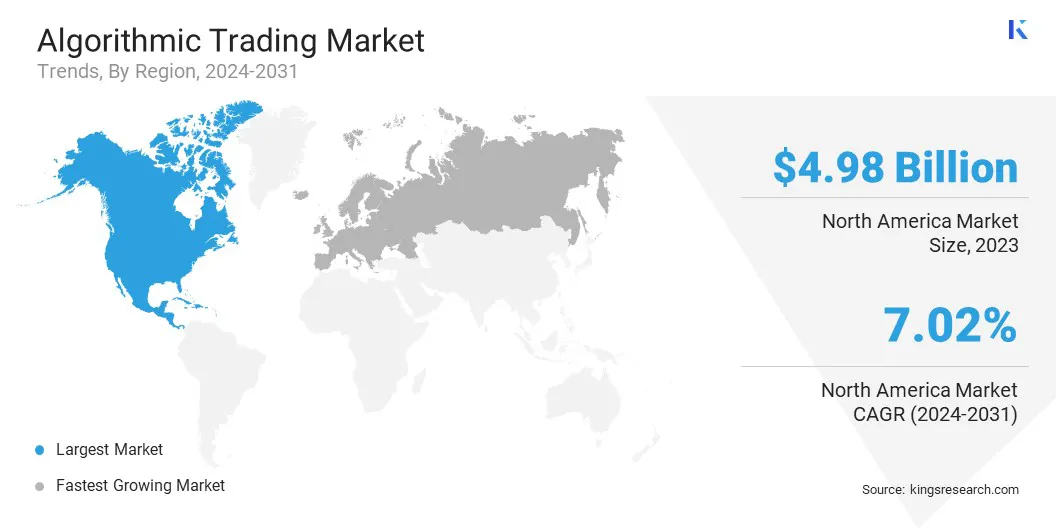Algorithmic Trading Market Size
The global Algorithmic Trading Market size was valued at USD 14.58 billion in 2023 and is projected to reach USD 25.68 billion by 2031, growing at a CAGR of 7.33% from 2024 to 2031. The market is witnessing notable expansion, driven by numerous factors, including technological advancements, favorable market conditions, and a burgeoning demand for innovative trading methodologies.
In the scope of work, the report includes products offered by companies such as QuantConnect, Symphony, TATA Consultancy Services Limited, Citadel Enterprise Americas LLC, Jane Street Group, LLC, Tradetron, IMC, Reuters, XTX Markets Limited, Wyden, and others.
With the rapid evolution of artificial intelligence, machine learning, and big data analytics, algorithmic trading is set to witness a surge in adoption rates across diverse market segments. A key factor supporting market development is the increasing sophistication of algorithmic trading systems. Market participants are capitalizing on cutting-edge algorithms to analyze vast datasets in real-time, identify lucrative trading opportunities, and execute trades with enhanced precision.
The integration of AI-powered predictive analytics is further empowering traders to gain deeper insights into market trends, thereby facilitating more informed investment decisions. Institutional investors and asset managers are increasingly turning to algorithmic trading to optimize their trading operations, drive cost efficiencies, and enhance portfolio performance.
Furthermore, regulatory reforms aimed at fostering market transparency and safeguarding investor interests are expected to propel the adoption of algorithmic trading practices.
- Compliance with regulatory mandates such as MiFID II and Regulation NMS are enabling market participants to demonstrate adherence to best execution practices and mitigate regulatory risks effectively.
The global algorithmic trading market encompasses the use of computer algorithms to execute trades automatically, based on predetermined criteria such as price, timing, and volume.
It operates across various financial markets, including equities, forex, commodities, and derivatives, catering to a diverse array of institutional investors, asset managers, hedge funds, and proprietary trading firms. Algorithmic trading systems leverage advanced technologies such as artificial intelligence, machine learning, and big data analytics to analyze market data, identify trading opportunities, and execute trades with precision and efficiency.

Analyst’s Review
The global algorithmic trading market is experiencing robust growth, driven by technological advancements, increasing market liquidity, and regulatory reforms. Algorithmic trading systems offer significant advantages, including enhanced efficiency, reduced trading costs, and improved risk management.
However, challenges such as technological risks, market fragmentation, and regulatory compliance complexities pose hurdles for market participants. Despite these challenges, the market outlook remains positive, with growing demand from institutional investors and asset managers seeking to capitalize on algorithmic trading strategies.
Algorithmic Trading Market Growth Factors
Increased efficiency and cost reduction are significant factors driving the adoption of algorithmic trading. As per analysis, over 70% of institutional investors are leveraging algorithmic trading to enhance order execution efficiency. By automating tasks, algorithmic trading reduces human error and minimizes transaction costs, thereby improving overall operational efficiency and profitability for market participants.
Moreover, the surging adoption of high-frequency trading (HFT), has further fueled the growth of the algorithmic trading market. These fast-paced markets are characterized by rapid price movements and large trade volumes, making algorithmic trading important for firms seeking to promptly respond to such changes. The ability to execute trades swiftly and capitalize on fleeting opportunities has positioned algorithmic trading as an essential tool in modern trading strategies.
Furthermore, the rise of alternative data in algorithmic models is projected to propel market growth over the forecast period. Beyond traditional financial data, alternative data sources such as social media sentiment analysis and consumer spending patterns are being increasingly integrated into algorithmic trading strategies.
- As per analysis, over 80% of respondents indicated that they planned to integrate alternative data into their operations by 2023, highlighting the growing importance of these sources in identifying trading opportunities and gaining a competitive edge.
However, the market faces several challenges, particularly during periods of market volatility. While algorithmic strategies excel in liquid and stable market conditions, they impair losses during times of increased volatility, underscoring the need for robust risk management strategies to mitigate potential downsides.
Additionally, the dependence on technology exposes operations to risks such as system failures, cyberattacks, and data security breaches, emphasizing the importance of implementing stringent security measures and contingency plans to safeguard trading operations and investor interests.
Algorithmic Trading Market Trends
The integration of environmental, social, and governance (ESG) factors into algorithmic trading strategies reflects a growing emphasis on sustainable and ethical investing practices. As investors are increasingly prioritizing ESG considerations in their investment decisions, algorithmic trading systems are adapting to incorporate ESG criteria into their decision-making processes.
By analyzing ESG data alongside traditional financial metrics, algorithmic strategies identify investment opportunities that align with investors' sustainability objectives, fostering the integration of ESG factors into trading algorithms.
Additionally, the development of quantamental strategies represents a convergence of quantitative analysis and fundamental analysis in algorithmic trading. This hybrid approach combines the advantages of algorithmic models, renowned for their proficiency in processing vast amounts of data and identifying patterns, with human expertise in interpreting qualitative information and understanding market dynamics.
By leveraging both quantitative and qualitative insights, quantamental strategies aim to enhance decision-making accuracy and capture investment opportunities that may be overlooked by purely algorithmic or fundamental approaches. This trend highlights the evolution of algorithmic trading strategies towards more adaptive methodologies that combine the strengths of human judgment with technological innovation.
Segmentation Analysis
The global algorithmic trading market is segmented based on deployment mode, trading type, end user, and geography.
By Deployment Mode
Based on deployment mode, the market is bifurcated into cloud and on-premises. The cloud segment generated the highest revenue of USD 9.18 billion in 2023. The scalability and flexibility offered by cloud deployment have enabled algorithmic trading firms to adapt to fluctuating market demands efficiently.
Additionally, the cost-effectiveness of cloud-based solutions, with reduced upfront investment and lower maintenance costs, is attracting market participants seeking to optimize operational expenses. Moreover, the accessibility and ease of deployment associated with cloud platforms appeal to a wide range of algorithmic trading firms, thus facilitating rapid deployment.
By Trading Type
Based on trading type, the market is categorized into stock market, foreign exchange, exchange-traded fund, bonds, cryptocurrencies, and others. The stock market segment captured the largest share of 37.86% in 2023. The liquidity and depth of the stock market present numerous trading opportunities to capitalize on price action and execute trades swiftly.
Additionally, the established infrastructure and regulatory framework surrounding stock markets provide a conducive environment for algorithmic trading activities, which is fostering the growth of the segment. Moreover, the availability of vast historical data and advanced analytics tools enable algorithmic traders to develop sophisticated trading strategies tailored for the stock market, which is driving innovation and competitiveness within the segment.
By End User
Based on end user, the market is classified into short-term, long-term, retail investor, and institutional investor. The institutional investor segment is projected to account for the highest revenue of USD 8.76 billion by 2031.
Institutional investors, with their substantial financial resources and sophisticated investment strategies, leverage algorithmic trading solutions to optimize portfolio performance and achieve superior risk-adjusted returns. Additionally, regulatory requirements and compliance standards impose stringent mandates on institutional investors, which necessitates the adoption of algorithmic trading technologies to ensure transparency, efficiency, and compliance with regulatory frameworks.
Furthermore, the increasing trend of institutional investors allocating a greater portion of their portfolios to alternative assets and complex trading strategies underscores the growing reliance on algorithmic trading solutions to navigate evolving market dynamics and capitalize on investment opportunities.
Algorithmic Trading Market Regional Analysis
Based on region, the global algorithmic trading market is classified into North America, Europe, Asia-Pacific, MEA, and Latin America.

The North America Algorithmic Trading Market share stood around 34.16% in 2023 in the global market, with a valuation of USD 4.98 billion. The robust trading market and widespread adoption of technological developments, underscored by a well-established financial infrastructure, have propelled significant investments in cutting-edge algorithmic trading solutions.
- According to Fidelity Investments, 85% of US institutional investors currently utilize algorithmic trading strategies.
Furthermore, companies in North America exhibit a notable focus on high-frequency trading, emphasizing speed and efficiency in execution. Moreover, regulatory scrutiny surrounding algorithmic trading practices has spurred the development of solutions aimed at ensuring compliance and transparency, offering potential opportunities for firms to innovate and provide regulatory and compliance solutions tailored to the region's stringent regulatory environment.
Europe is anticipated to capture a substantial revenue of USD 7.14 billion by 2031. This notable growth is primarily driven by the stringent regulatory environment and the expanding investment landscape.
The imposition of strict regulations, including MiFID II (Markets in Financial Instruments Directive II), underscores a commitment to investor protection and market integrity. This regulatory environment is driving the development of algorithmic trading solutions tailored to comply with regulatory mandates, thereby positioning European firms as leaders in adopting responsible and compliant trading practices.
Additionally, Europe's major role in sustainable investing enhances the appeal of algorithmic trading solutions that integrate ESG factors, making them particularly attractive to investors.
Competitive Landscape
The global algorithmic trading market report will provide valuable insight with an emphasis on the fragmented nature of the industry. Prominent players are focusing on several key business strategies such as partnerships, mergers and acquisitions, product innovations, and joint ventures to expand their product portfolio and increase their market shares across different regions. Companies are adopting lucrative measures including broadening their range of services, allocating resources to research and development (R&D), establishing state-of-the-art service delivery centers, and streamlining their service delivery processes, to gain a strong foothold in the market.
List of Key Companies in Algorithmic Trading Market
The Global Algorithmic Trading Market is Segmented as:
By Deployment Mode
By Trading Type
- Stock Market
- Foreign Exchange
- Exchange-Traded Fund
- Bonds
- Cryptocurrencies
- Others
By End User
- Short-Term
- Long-Term
- Retail Investor
- Institutional Investor
By Region
- North America
- Europe
- France
- U.K.
- Spain
- Germany
- Italy
- Russia
- Rest of Europe
- Asia-Pacific
- China
- Japan
- India
- South Korea
- Rest of Asia-Pacific
- Middle East & Africa
- GCC
- North Africa
- South Africa
- Rest of Middle East & Africa
- Latin America
- Brazil
- Argentina
- Rest of Latin America


